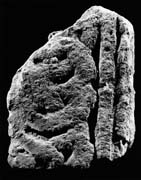Select a site alphabetically from the choices shown in the box below. Alternatively, browse sculptural examples using the Forward/Back buttons.
Chapters for this volume, along with copies of original in-text images, are available here.
Object type: Fragment of cross-shaft(?)[1]
Measurements: H. 30.5 cm (12 in); W. 22.3 cm (8.75 in); D. 22.3 cm (8.75 in)
Stone type: Fine- to medium-grained, calcareous, pale brown (10YR 8/4) sandstone; Middle Calcareous Grit, Coralline Oolite Formation, Middle Oxfordian, Upper Jurassic; perhaps from Stonegrave or Malton areas (see Fig. 5).
Plate numbers in printed volume: 26-29
Corpus volume reference: Vol 3 p. 57-58
(There may be more views or larger images available for this item. Click on the thumbnail image to view.)
Only one face is carved.
There is a double edge moulding. The outer one is cabled, the other flat. Within the panel is a fragment of deeply cut interlace, using broad, flat strands. The form of the pattern is uncertain; it may have been bungled.
This is clumsy but ambitious work. The remains of the interlace point to the Anglo-Scandinavian period.
1. All the pieces from the Minster were discovered as a result of the excavations of 1966-71 by H. Ramm and D. Phillips. They are to be published as a handlist, together with a critical essay, in the forthcoming Royal Commission volume on the excavations. That publication will provide the finer detail of their archaeological contexts, both in a table, and in a description of the excavation of the south transept cemetery.
The following are general references to the stones: Wilson 1978, 142; Hall 1980b, 7, 21; Lang 1988b, 8, 12; Lang 1989, 5.



